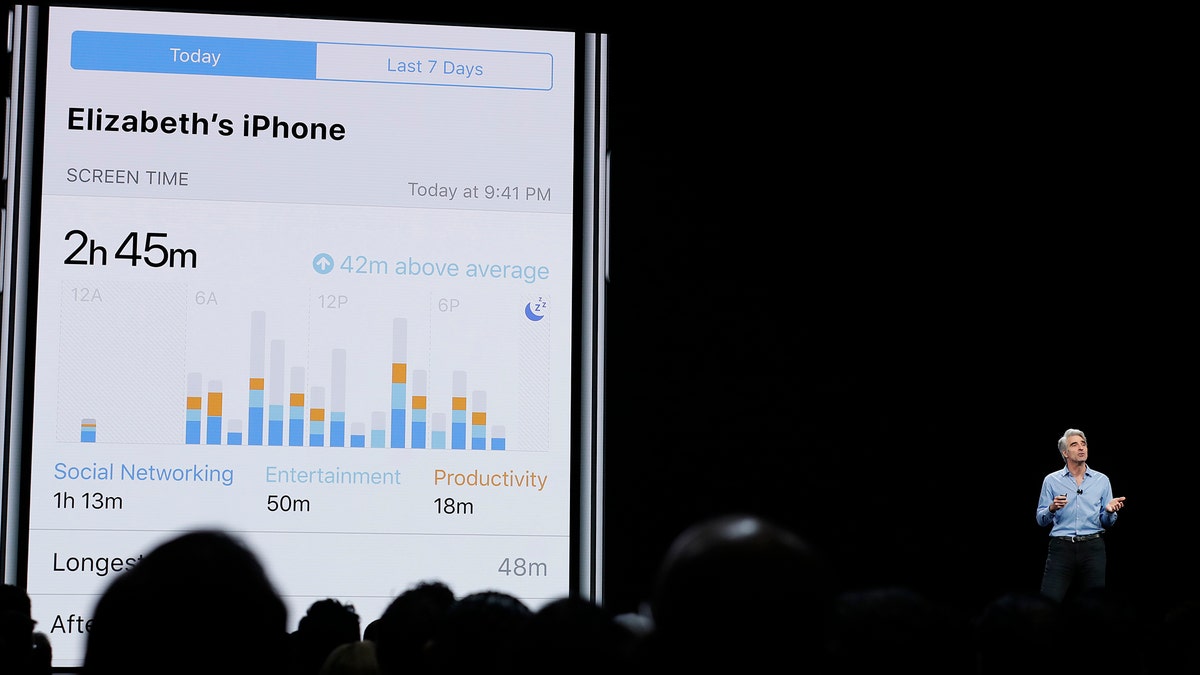
Craig Federighi, Apple's senior vice president of Software Engineering, speaks about screen time during an announcement of new products at the Apple Worldwide Developers Conference Monday, June 4, 2018, in San Jose, Calif. (AP Photo/Marcio Jose Sanchez)
A leaked internal memo from Apple has sparked concerns the company will dramatically restrict the ability of customers to repair their devices themselves or get replacement parts from third party repair shops.
The memo was sent to Apple stores and authorized service providers outlining security features of Apple’s new T2 chip which appears in the latest iMac Pro and 2018 models of the MacBook Pro.
It revealed that certain repairs would require Apple’s proprietary software used by Genius workers in Apple stores and authorized repairers to be completed. Failure to run Apple diagnostics after certain parts are replaced in T2-equipped Macs and notebooks “will result in an inoperative system and an incomplete repair,” the memo said.
The internal communication was first reported by MacRumours and then put to iFixit CEO Kyle Weins who works tirelessly to advocate for consumers to have the right to repair, particularly against Apple which likes to keep a tight control over its products and how they are maintained.
According to the memo, the restrictions will apply to repairs that involve replacing a MacBook Pro’s display assembly, logic board, the keyboard and touchpad and the Touch ID board. On iMac Pros, it will kick in if the Logic Board or flash storage are replaced.
Despite the wording of the internal memo, the iFixit team were successfully able to replace the display and logic board of a MacBook Pro without any issues.
“That’s a promising sign, and it means the sky isn’t quite falling — yet. But as we’ve learned, nothing is certain,” iFixit said in a blog post about the tear down.
But as the organization is quick to point out, the tech giant has a history of software-blocking repair scandals including the device-disabling Error 53 saga which saw the ACCC slug Apple $9 million for misleading Australian consumers and the recent iPhone throttling scandal in which it was revealed Apple was deliberately slowing down older phones.
At least for now, Apple doesn’t appear to be monopolizing the ability to repair its new laptop and desktop computers. However the story has reignited a debate about planned obsolescence and how companies try to control the life of their products after the point of sale.
The situation described in the Apple memo has been referred to by critics as a type of “kill switch” that could render devices useless unless taken to an Apple store.
If Apple chooses to, the latest repair requirement could mean customers have little choice about how they fix their devices.
“Basically it means Apple owns your device, not you, and could conceivably disable it remotely if they detect unauthorized repairs going on,” iFixit said.
“This would be a big step, even for them.”
Australia has right to repair laws on the books for the car industry after five leading automotive industry bodies signed an agreement in December 2014 paving the way for information sharing.
However there is no such mandate for other industries like manufacturers of electronics or farming equipment, where replacement parts and diagnostic tools are often carefully guarded by the manufacturer.
SMARTPHONES AND PLANNED OBSOLESCENCE
Is planned obsolescence real? The short answer is yes.
The extent to which it exists today depends on how conspiratorially minded you are. But far from promoting a caricature of greedy companies fleecing their customers, product makers are often bound by imperfect technology and a majority of times are simply responding to the desires of consumers who want a sleek new device every few years.
The term planned obsolescence has its origins in the US light bulb industry in the 1920s when a group of light bulb manufacturers — infamously known as the Phoebus cartel — conspired to prevent technological advances that would have produced longer-lasting light bulbs.
For some, today’s smartphone is the new light bulb.
Screens or buttons break. Operating systems, apps and so on suddenly can no longer be upgraded. And the lithium batteries in smartphones soon die.
Speaking to news.com.au last year, iFixit CEO Kyle Wiens lamented how difficult Apple makes it to simply replace the battery in its iPhones.
“Any time you’re taking a battery and gluing it into a product, you’re building planned obsolescence,” Mr. Wiens said. “Batteries have a limited life, just like the tires on your car have a limited life and if a car manufacturer tried to sell a car with tires you can’t replace everybody would laugh at them, but that’s exactly what happens with cell phones and laptops these days.”
This story originally appeared in news.com.au.




















